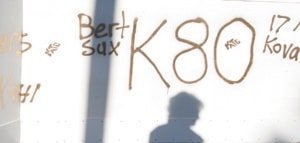Death to Indians has been spray-painted in gold on a wooden park barrier in Granger.
And KKK is scrawled on the freshly painted boards around the outdoor rink.
It’s a sad reflection of the state of some youthful minds, and is terribly discouraging to many of the subdivision’s hard-working, civic-minded residents.
The Granger Park received a $33,685 Community Development Fund makeover in September.
The rink was paved and the boards and doors were replaced.
“We even got puckboard for it,” said Granger Community Association president Paulette Ruest on Thursday.
Although contractors were hired to do the paving and replace the boards, volunteers did all the painting.
“And no sooner did we do the painting than it was defaced,” said Ruest.
“It’s so infuriating.
“It’s just so many hours down the drain.”
The boards, which still needed one more coat, are now going to need several, she said.
“And it’s really hard to get volunteers.”
Three park signs and several of its big rocks were also spray-painted.
The vandalism occurred Tuesday night, and Ruest has left a message with the RCMP.
This is not the first time vandals have defaced Granger Park.
There used to be a picnic table under the gazebo, said Ruest.
But kids used it to climb up in the rafters to spray-paint the beams and plywood roof.
They also got up on the roof and tore all the shingles off, she said.
“This is why it’s now a metal roof.
“And that’s why the metal picnic table now sits outside, cemented in place.”
Kids used to make bonfires out of the wooden ones, she added.
“It’s really disheartening for those who try to provide a facility for the community to enjoy, and volunteer their time,” said Ruest.
Since ‘93, Ruest’s husband has mowed the park twice a week, all summer.
He volunteers his time.
“People think he works for the city,” said Ruest with a laugh.
Before the irrigation system was installed, the couple also used to water the park from their backyard.
Now, Ruest is careful to hide the irrigation outlets.
“Because otherwise kids throw stones down them and jam them,” she said.
Kids also smash the hose attachments in the summer, which are $80 a pop.
Next spring, once it’s warm enough, Ruest will search out more volunteers to repaint the boards.
“And I guess we’ll have to take the signs down,” she said.
“There’s no point leaving them there like that.”
Parks and recreation spends $100,000 a year just cleaning up vandalism, said Ruest.
“It’s always just a matter of how long it takes until someone comes along and ruins things.”
In the past month, this area has seen an increase in vandalism that includes several gas-ignited fires along the trail between Granger and Hillcrest, the burning of Elijah Smith Elementary School’s tire swing, the theft of two of Nlaye Ndasadaye Day Care’s tricycles and a number of car break-ins.
ENVIRONMENT
Why did the caribou
cross the road?
Caribou are like ants.
Admittedly, there’s a bit of a size difference. And they don’t have quite as many legs.
But, like ants, they follow each other’s trail.
And this is what Yukon conservation officers are hoping will happen this week, as the Porcupine caribou herd approaches the Dempster Highway.
The herd was spotted Tuesday and over subsequent days hunters coming across the Peel River by ferry harvested about 100 animals, said Dawson conservation officer Torrie Hunter.
This harvest is a concern because it was probably herd leaders who were shot, he said.
“And we want to let the ones in the lead go where they want to go without being shot.”
Following recommendations from Fort McPherson, the Dempster is closed to hunting for a week every year to assist with the caribou’s highway crossing.
Unfortunately, after the herd was shot at Wednesday and Thursday, the caribou didn’t cross the highway. Instead they travelled west along its edge, said Hunter.
“But it might have just been the edge of the group that was pushed away from the road,” he said.
“And hopefully in the coming week of peace they will cross.”
A portion of the herd’s winter range is east of the highway.
“And the concern is, if they don’t cross, they won’t inhabit all of their winter range,” said Hunter.
Since ‘99, the Dempster has been closed to hunting while the caribou cross, said Environment spokesman Dennis Senger.
There is no caribou hunting for eight kilometres on either side of the highway, from the Ogilvie Bridge at kilometre 195 through to the Yukon/Northwest Territories border at kilometre 495, he said.
The hunting ban starts October 27th at 6 p.m. and is in effect for one week.
Following radio collar signals, Environment knew the caribou were on the move Monday and hoped to fly over the herd Tuesday for confirmation. But weather didn’t allow it.
“And we didn’t want to put the closure into effect until we knew for sure whether they were near the highway or not,” said Senger.
“You don’t want to shut the highway for a week, then find out it was too soon.”
Environment also tries to give the public, hunters and outfitters at least 48 hours notice before the closure comes into effect.
“It’s spectacular — it’s a phenomenal sight,” said Senger.
The herd spotted near the road contains 1,000 to 1,500 caribou, said Hunter.
The entire herd contains about 110,000, he said. (GK)
